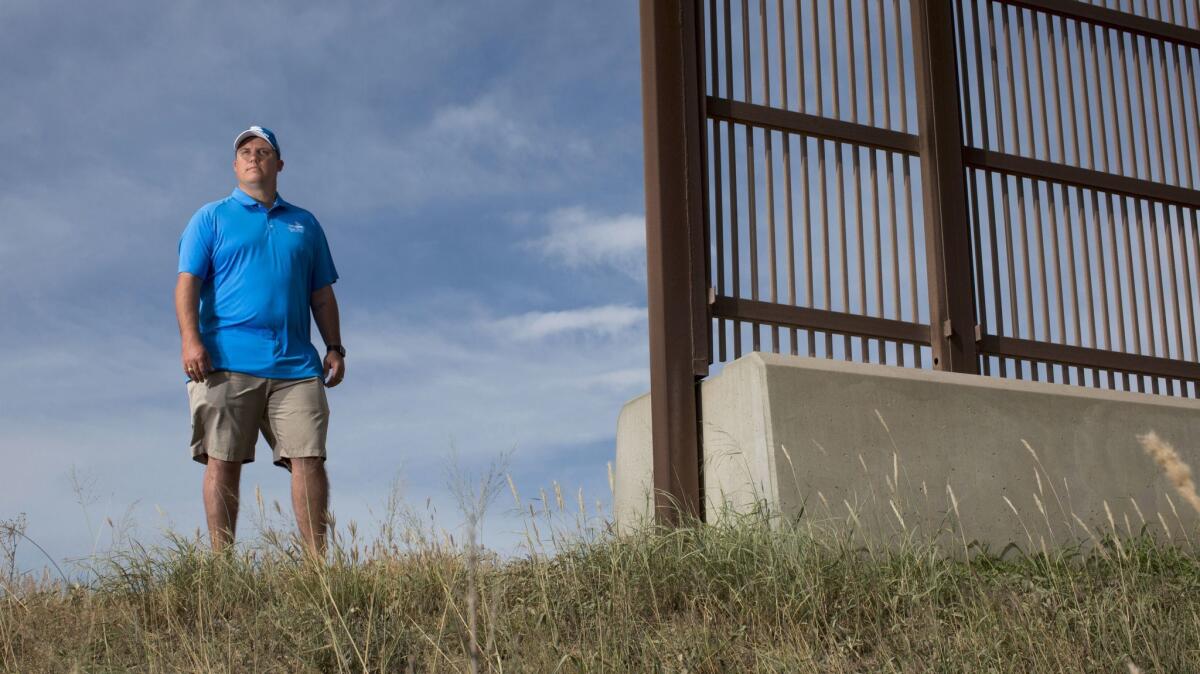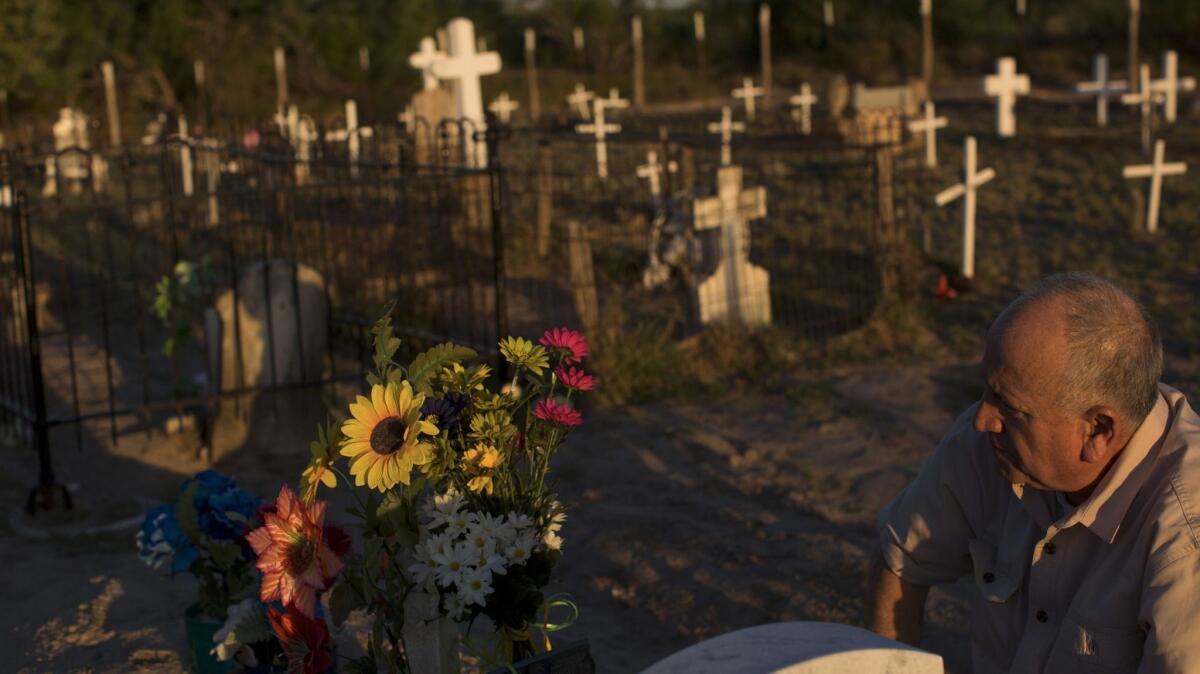Trump promised a border wall. Now these Texans worry the government will take their land

Mauricio Vidaurri, 58, a rancher and farmer whose family has owned 1,300 acres about 20 miles south of Laredo since 1750, has yet to hear from federal officials. But as he listens to Trump, he wonders what would happen to his water rights. To grow h
Reporting from ROMA, TEXAS — For 2½ centuries, Cecilia Benavides’ family has owned land tangled with honey mesquite trees and towering clumps of cactus on a sweeping bend of the Rio Grande.
Generations have gathered by the water’s edge to swim, fish for catfish and alligator gar and hold Easter jamborees.
But this land is considered prime territory for something more than swimming and fishing: For years, the federal government has pondered a way to build a stronger barrier across it to halt illegal immigration from Mexico.
In February, federal authorities made the long-looming threat concrete. A letter from the U.S. attorney in southern Texas informed the Benavides family that the government intends to seize a 60-foot-wide strip of the property to build new sections of a border wall.
“It’s a beautiful piece of land, just like it was when the original settlers came over,” Noel Benavides, 74, Cecilia’s husband, said of the rustic plot where bobcats and peccaries roam. “You go in, and it’s a different world — but that’s not going to be once we have a big wall that cuts through the ecosystem.”
A string of ranchers, farmers and others who own property across the Rio Grande Valley have received similar condemnation letters from the Department of Justice in recent months, all resulting from a 2006 initiative launched by President George W. Bush to build new, secure fencing along the Southwest border.
The land condemnations are expected to increase substantially with President Trump’s plans to build new sections of wall. Already, Trump has requested that Congress fund the hiring of 20 additional federal attorneys to work on land acquisition for a border wall.
The initiative has sparked deep worry here, where many landowners fear it will change the character of their historic communities, cut off water access, stifle commerce and disrupt the movement of wildlife.
“This is a battle,” said U.S. Rep Henry Cuellar, a Democrat whose district covers 280 miles of the border. “In Texas, we have a long tradition of private property rights. Any time big government starts using eminent domain and taking land — especially the valuable part, access to water — then it becomes a battle cry. Lawsuits will definitely be coming in.”

Jeremy Barnard, general manager of the River Bend Resort & Golf Club in Brownsville, Texas, says his family has put expansion plans on hold because they worry a wall would slice off the bulk of their investment.
Some landowners, however, worry that they have little choice but to cede the land to federal authorities.
“It’s something that the government wants and the government can take,” said Noel Benavides, who does not expect to mount a legal challenge. “There’s no way to fight it.”
About a third of the 1,954-mile border between the U.S. and Mexico, in the most populated cities, is already fenced. But here in the valley, where the winding Rio Grande forms a natural dividing line, less than a fifth of the border has fencing.
The challenges of building a wall in the floodplains of the valley — a hot spot for drug smugglers and for Central American families and unaccompanied children seeking asylum — are immense. Not only does construction near the river present engineering difficulties and potential flood hazards, but many small landowners also have long-standing historic and cultural ties to their property and depend on the river to irrigate their crops.
Condemnation of riverfront land around the small communities of Roma, Rio Grande City and Los Ebanos has loomed since 2008, when property owners near highly populated sections of the border received official notices from the government.
About 56 miles of fencing went up, most on levees above the Rio Grande on land the government took through eminent domain. Plans to build another 14 miles were abandoned because an international treaty restricts building in the floodplain, said Scott Nicol, co-chair of the Borderlands Team for the Sierra Club.
Of the roughly 350 condemnation cases stemming from that era, about 85 have not been settled, according to the U.S. attorney’s office.
“No land has been condemned in South Texas to date as a result of any executive order of the current administration,” the office said in a statement. “The current cases in litigation are not connected to the current border security initiative.”
But if Trump pushes his plans for a “big, beautiful wall,” more landowners in less-populated areas are expected to receive similar letters. The exact path of the wall has yet to be determined. Still, many who own land along the Rio Grande are worried.
A wall is a 14th century solution to a 21st century problem.
— Henry Cuellar, Texas congressman
The government is required by law to offer fair market value for property it condemns. Historically, the landowners on the border have not been offered a lot of compensation, Nicol said.
“They’re really lowballing these landowners, but it gets really expensive to fight” the government, he said. “It’s tragic for those that can’t afford a lawyer. They know they’re ultimately going to lose, and if they hire a lawyer, everything is going to be eaten up by legal fees.”
One recent condemnation letter offered a family in the tiny town of Los Ebanos $2,900 for 1.2 acres. Benavides declined to say how much he had been offered, other than “not enough.” Although the government plans to condemn a strip of land that equals 5.78 acres, he noted it could essentially cut off 15 acres more, with no compensation.
Along the Rio Grande Valley, landowners who are reluctant to give up their riverfront tracts, like the Benavides family, take pains to emphasize they are not opposed to security. Border Patrol agents, they note, have free rein to search their land for immigrants entering the country illegally. Already, a virtual wall runs through their properties, in the form of cameras, ground sensors, radar installations and drones.
Investing in more technology, as well as more boots on the ground, would be more effective and less costly than a physical barrier, many locals argue.
“A wall is a 14th century solution to a 21st century problem,” Cuellar said. “Some people feel if you put up a fence that’s a way to secure the border, but in my opinion that only gives a false sense of security.”
As Terence Garrett, professor of political science at the University of Texas Rio Grande Valley, put it, “A 30-foot wall simply means they bring 31-foot ladders.”
At some points on the border, it’s not clear where a wall might stand. The old town of Roma, population 10,000, is perched high on steep, sandstone bluffs above the Rio Grande across from the Mexican town of Ciudad Miguel Alemán, and immigrants and drug smugglers regularly clamber up the riverbank here. A wall could threaten the town’s scenic views, and butt up against its main plaza and some of its historic stone and brick buildings.
Some landowners who have yet to receive letters said they might be amenable, if the price is right.
“The government has to be reasonable,” said Fernando Pena, 55, a Roma businessman who owns a nearby riverfront tract. “You can’t just take someone’s land and give them whatever you want.”
Still, Pena said he did not think a border wall would do much good. “There’s smart technology out there,” he said. “A wall will be a permanent eyesore for the community and a symbol of division.”

About 100 miles southeast of Roma in Brownsville, Jeremy Barnard, general manager of the River Bend Resort & Golf Club, has had no contact with the federal government. The development already has about 340 houses, but his family, which took over the 319-acre resort in 2015, has put on hold plans to build $500,000 homes because they worry a wall would slice off the bulk of their investment.
Border walls are often built on existing levees, and if a wall topped the levee that cuts through the resort, 15 of its 18 golf holes — and 240 existing homes — would probably end up marooned between the wall and the Rio Grande.
“If we could just have dialogue with him,” Barnard said of Trump, whom he supports. “He’s a golf course owner. I would love for him to come down and play the course and see what it would mean for our business.”
Barnard, in turn, has questions for Trump: Where would the barrier go? What would it look like — steel bars like a prison fence or a stucco wall? Would it have a gate to allow access to golfers and those who owned homes on the Mexico side?
“We have 30,000 golfers coming through a year,” he said. “Are we going to give 30,000 people a code?”
For those who have longer, more deep-rooted attachments to their land, a wall cutting through their property is hard to imagine.

Mauricio Vidaurri, 58, a rancher and farmer whose family has owned 1,300 acres about 20 miles south of Laredo since 1750, has yet to hear from federal officials. But he assumes he will, since his property abuts the river, and as he listens to Trump, he wonders what would happen to his water rights. To grow hay, he relies on a pipeline that channels water from the river.
Even more, he worries about losing access to the nearly 200-year-old family cemetery where his great-grandfather, grandfather and father — a Marine who fought on Iwo Jima — are buried. A wall could also close off the ruins of the historic stone settlement where his father was born.
“I don’t think Trump understands the big picture,” he said. “Are they going to cut us from our family history? We were here before the United States was the United States. We shed our blood, our tears and our sweat long before Washington, D.C., was the capital. For someone to come around and say, ‘We’re going to build a wall right here on your land, that’s a slap in the face.’”
Jarvie is a special correspondent.
ALSO
Trump’s border wall just got real: The builders have submitted their plans
You can build a wall -- except here, a river runs through it
More to Read
Sign up for Essential California
The most important California stories and recommendations in your inbox every morning.
You may occasionally receive promotional content from the Los Angeles Times.









